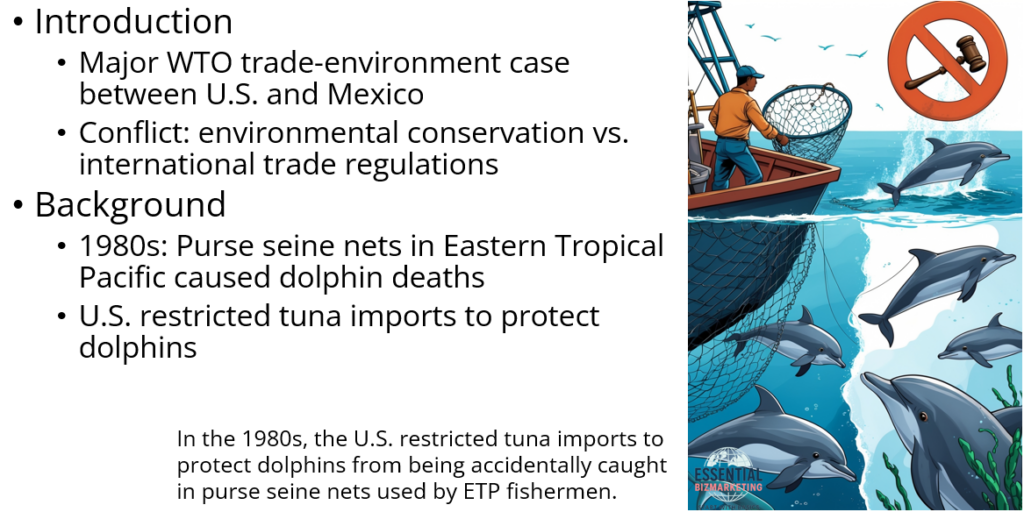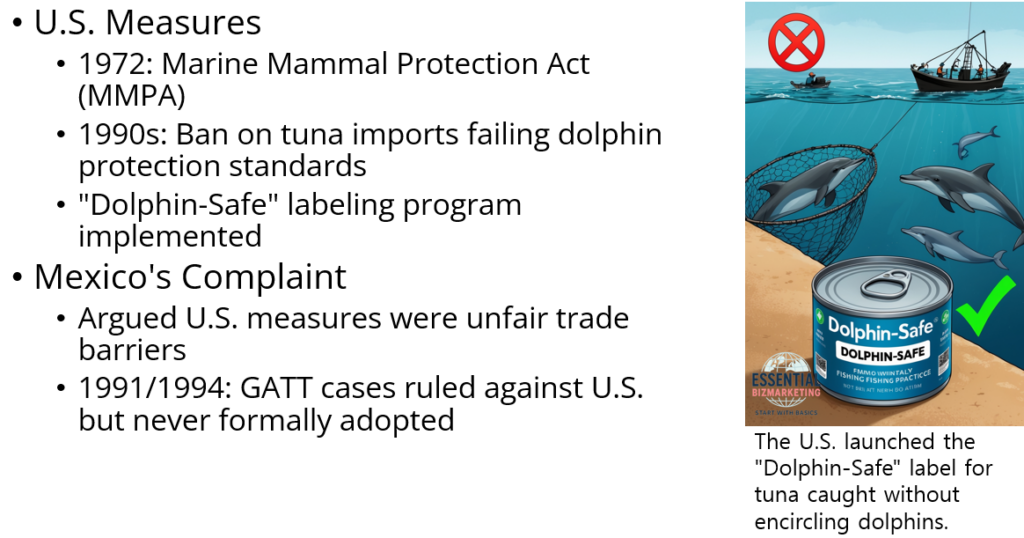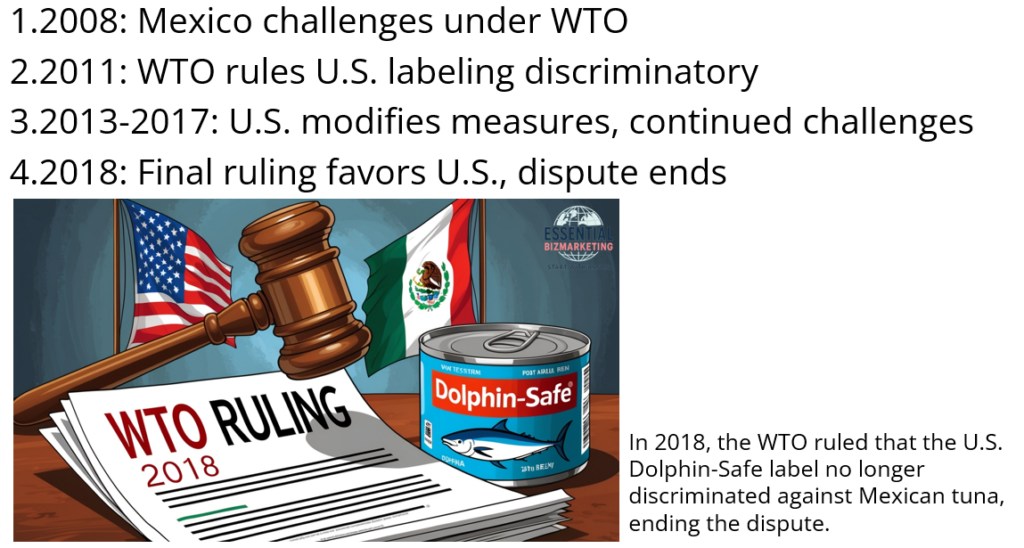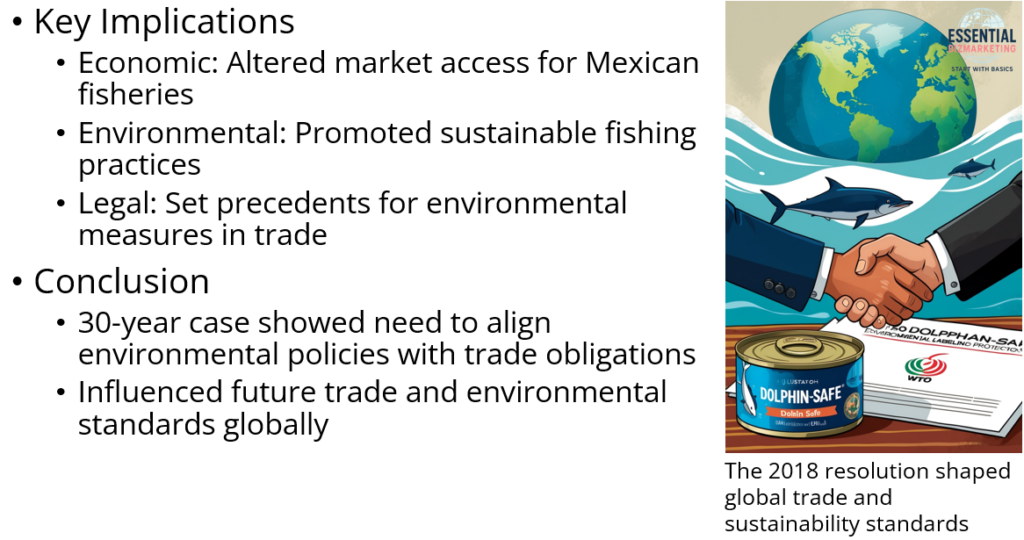Introduction

The Tuna-Dolphin dispute is one of the most significant trade and environmental cases in the history of the World Trade Organization (WTO). It revolves around the conflict between environmental conservation efforts and international trade regulations. The case was primarily contested between the United States and Mexico, with implications for global fisheries, environmental standards, and trade law.
Background
In the 1980s, environmental concerns emerged regarding fishing methods used by certain countries, particularly in the Eastern Tropical Pacific (ETP) region. Fishermen in this region used purse seine nets to catch tuna, a method that often led to the incidental capture and killing of dolphins, as tuna and dolphins tend to swim together. In response, the U.S. enacted measures restricting the import of tuna caught using these methods, aiming to protect dolphin populations.
The U.S. Regulations and Trade Measures

The United States introduced the Marine Mammal Protection Act (MMPA) in 1972, which aimed to reduce dolphin mortality rates in tuna fishing. In the early 1990s, the U.S. banned the import of tuna from countries that failed to meet dolphin protection standards comparable to those imposed on U.S. fishermen. Additionally, the U.S. introduced a “Dolphin-Safe” labeling program, restricting the use of the label to tuna caught without purse seine nets that encircle dolphins.
Mexico’s Complaint and GATT/WTO Dispute
Mexico, a major tuna exporter, argued that the U.S. measures constituted an unfair trade barrier. In 1991 and 1994, Mexico brought the case before the General Agreement on Tariffs and Trade (GATT), the predecessor of the WTO, claiming that the U.S. restrictions violated international trade rules. The GATT panel ruled against the U.S., stating that the import bans were inconsistent with trade agreements. However, these rulings were never formally adopted due to the transition from GATT to the WTO.
WTO Proceedings and Rulings

The dispute resurfaced under the WTO framework in 2008, when Mexico again challenged the U.S. measures. The WTO Dispute Settlement Body (DSB) issued several rulings over the years:
- In 2011, the WTO ruled that the U.S. Dolphin-Safe labeling requirements were discriminatory against Mexican tuna exporters and created unnecessary trade restrictions.
- The U.S. modified its labeling requirements in 2013, but Mexico argued that the changes were still insufficient. The WTO ruled again in 2015 that the revised measures continued to violate trade rules.
- In 2017, the WTO Appellate Body determined that the revised U.S. labeling measures were now in compliance with WTO rules.
- In 2018, the WTO ruled in favor of the U.S., concluding that the Dolphin-Safe labeling program no longer discriminated against Mexican tuna products, effectively ending the dispute.
Economic and Environmental Implications

The Tuna-Dolphin case had significant consequences for trade and environmental policy. Economically, it influenced the global tuna trade by altering market access for Mexican fisheries. Environmentally, it reinforced the importance of sustainable fishing practices and led to increased international cooperation in protecting marine wildlife.
Legal and Trade Policy Lessons
The dispute highlights the complex interplay between trade law and environmental protection. It underscores the challenge of balancing environmental objectives with trade commitments under WTO agreements. It also set precedents for how countries can implement trade-related environmental measures without violating international trade rules.
Conclusion
The Tuna-Dolphin dispute, spanning over three decades, reflects the evolving nature of trade-environment conflicts. While the U.S. ultimately succeeded in defending its labeling program, the case demonstrated the necessity of ensuring that environmental policies align with global trade obligations. The resolution of the dispute in 2018 marked a milestone in reconciling trade and sustainability concerns, influencing future trade negotiations and environmental standards worldwide.
📚 References
World Trade Organization. (n.d.). Mexico etc. versus US: ‘tuna-dolphin’. World Trade Organization. Link
Sullivan, L. (2014). The epic struggle for dolphin-safe tuna: To be continued—A case for accommodating nonprotectionist eco-labels in the WTO. Vanderbilt Journal of Transnational Law, 47(3), 861–898. Link
Baroncini, E., & Brunel, C. (2020). A WTO safe harbour for the dolphins: The second compliance proceedings in the US–Tuna II (Mexico) case. World Trade Review, 19(3), 365–386. Link
Earth Island Institute. (2019, May 6). Explanation of the World Trade Organization case against dolphin safe tuna. Earth Island Institute. Link
Public Citizen. (n.d.). WTO Tuna-Dolphin case. Public Citizen. Link
Wikipedia contributors. (2023, October 1). Dolphin safe label. In Wikipedia, The Free Encyclopedia. Link
📁 Start exploring the Blog
📘 Or learn more About this site
🧵 Or follow along on X (Twitter)
🔎 Looking for sharp perspectives on global trade and markets?
I recommend @GONOGO_Korea as a resource I trust and regularly learn from.
